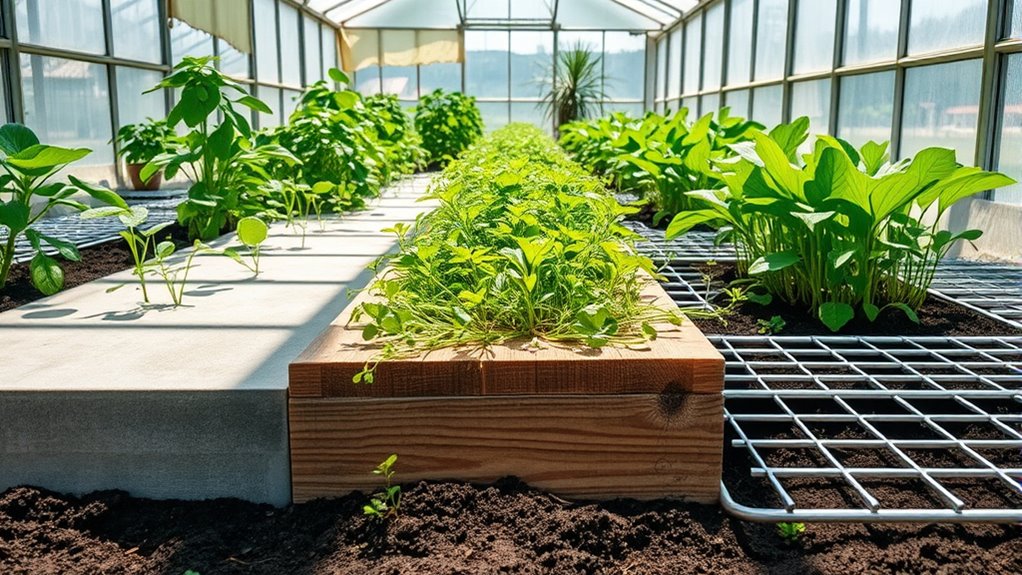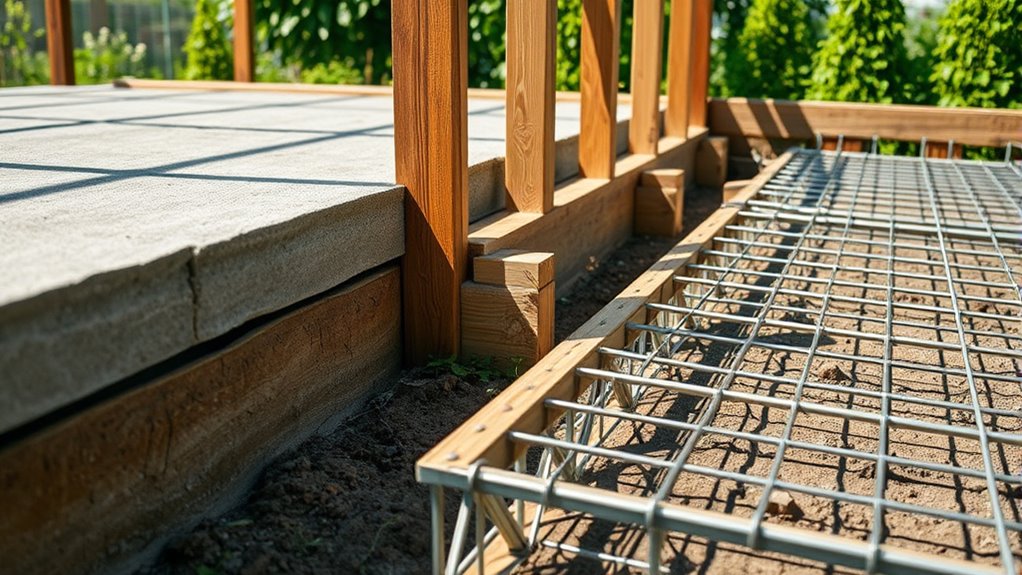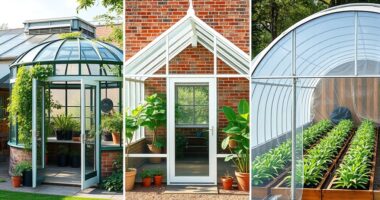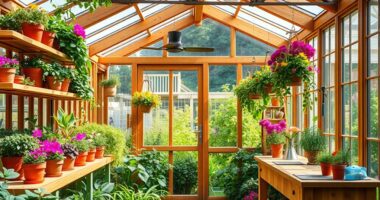When choosing a greenhouse foundation, consider concrete slabs for strength and stability, though they’re costly and require excavation. Raised beds and timber frames are more flexible and easier to modify but need maintenance over time. Gravel or stone foundations offer good drainage and quick installation, ideal for lightweight structures, but may lack support. Your site conditions, budget, and long-term needs influence the best choice—exploring each option further can help you make an informed decision.
Key Takeaways
- Concrete slabs offer durability and stability but are costly and require extensive installation and drainage considerations.
- Raised beds and timber frames are flexible and easier to modify but may need regular maintenance due to rot or warping.
- Gravel and stone foundations provide excellent drainage and affordability but are less supportive for heavy structures.
- Proper foundation choice improves greenhouse efficiency by enhancing ventilation stability and environmental control.
- Site conditions, budget, and long-term durability are crucial factors influencing the optimal foundation option.

Choosing the right foundation for your greenhouse is vital to guarantee stability, durability, and long-term performance. Your foundation sets the stage for everything inside, from the ventilation systems to watering automation, so it’s essential to pick a solid option that suits your needs and budget. If you’re considering concrete slabs, you’ll enjoy a sturdy, level surface that’s resistant to shifting and pests. Concrete is a popular choice because it offers excellent support for heavy structures and helps maintain consistent internal conditions. With a concrete foundation, you can better control temperature fluctuations, which benefits your ventilation systems by creating a stable environment for plants. However, installing concrete can be costly and time-consuming, especially if excavation and curing are involved. It also requires careful planning to guarantee proper drainage, preventing water pooling that could damage your structure or lead to mold.
Choosing a concrete slab ensures a sturdy, level foundation that resists shifting, supports heavy structures, and maintains consistent internal conditions.
Alternatively, raised beds or timber frames provide a more flexible and often more affordable foundation. These options are easier to install and modify, which is advantageous if you plan to expand or change your greenhouse layout over time. Raised beds elevate your plants and can improve drainage, reducing the risk of waterlogging that could compromise your watering automation systems. Plus, timber foundations are helpful in areas with uneven terrain, allowing you to level the structure more easily. The downside is that wood can rot or warp over time if not properly treated, potentially compromising stability. You’ll need to regularly inspect and maintain timber bases to guarantee your greenhouse remains sturdy.
Another option gaining popularity is a gravel or stone foundation, which offers excellent drainage and prevents water buildup beneath your structure. This type of foundation is relatively inexpensive and straightforward to install, making it a good choice for hobbyists or smaller greenhouses. Gravel foundations also promote airflow and reduce moisture issues, which can help regulate humidity levels inside—beneficial for your ventilation systems. On the downside, gravel doesn’t provide as much support as concrete, so it’s best suited for lightweight structures or temporary setups. You might also need to add a border or edging to keep the gravel contained and maintain a clean, professional appearance.
No matter which foundation you choose, remember that it impacts your greenhouse’s overall efficiency. Properly installed foundations can enhance your ventilation systems by maintaining a stable environment and can make watering automation more reliable by reducing uneven settling or shifting. Investing time and effort into evaluating your specific needs, budget, and site conditions will guarantee you select the best foundation option that guarantees your greenhouse’s longevity and performance.
Frequently Asked Questions
Which Foundation Type Is Best for Uneven or Sloped Terrain?
For uneven or sloped terrain, you should consider pier or post foundations, which are ideal for sloped terrain solutions. They elevate the greenhouse above uneven ground, providing better uneven ground stabilization. By using adjustable piers or posts, you can level the structure easily, ensuring stability and safety. This option minimizes excavation and adapts well to challenging terrain, making it the best choice for maintaining a sturdy, level greenhouse on uneven ground.
How Do Foundation Options Impact Greenhouse Insulation Efficiency?
Your foundation options substantially impact greenhouse insulation efficiency, mainly through foundation insulation and thermal conductivity. A well-insulated foundation reduces heat loss, maintaining consistent temperatures inside. Materials with low thermal conductivity, like foam or insulated concrete, enhance insulation. Choosing the right foundation type allows you to minimize energy costs and improve climate control, especially in colder climates or uneven terrain, ensuring your greenhouse stays warmer and more energy-efficient.
Are There Eco-Friendly Foundation Choices for Greenhouses?
You’ll be surprised to find eco-friendly foundation choices that support sustainable materials and eco-friendly construction. Options like recycled concrete, insulated straw bale, or untreated timber not only reduce environmental impact but also enhance your greenhouse’s insulation. These sustainable materials promote energy efficiency and longevity. By choosing eco-conscious foundations, you’re taking a vital step toward greener, more sustainable greenhouse building—making a positive difference for the planet and your garden’s future.
What Is the Typical Lifespan of Different Greenhouse Foundations?
You can expect the lifespan of greenhouse foundations to vary based on the foundation material and installation quality. Concrete foundations typically last 25-50 years with proper maintenance, while wooden ones might last 10-20 years due to decay. Metal foundations can last around 20-30 years if protected from rust. Proper foundation installation ensures longevity, so investing in quality work and materials can profoundly extend your greenhouse’s lifespan.
How Do Foundation Options Affect Greenhouse Expansion or Relocation?
Your choice of foundation impacts greenhouse expansion or relocation considerably. Stable foundations ensure foundation stability, making it easier to expand or move the structure later. However, some options might increase construction costs, especially if extensive groundwork is needed or if you opt for more durable materials. Carefully selecting a foundation that balances stability and cost helps you plan for future growth or relocation, saving you time and money down the line.
Conclusion
In the end, choosing the right greenhouse foundation isn’t just about practicality — it’s about creating a sturdy home for your plants’ dreams. Each option offers its own gentle advantages and subtle challenges, so trust your instincts and consider what suits your space and goals best. With a thoughtful choice, you’ll nurture a thriving green oasis that stands the test of time, inviting growth and success in every season. Your garden’s future begins with your foundation choice.









